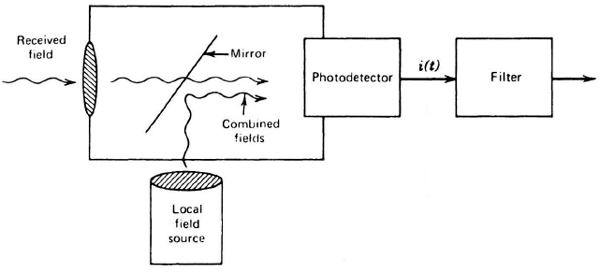5.1 THE HETERODYNE RECEIVER
A typical heterodyning receiver is shown in Figure 5.1. The received optical field is projected onto the photodetector surface by the receiver lens and front-end system. A local optical field, generated by a receiver source, is diffracted by a receiver lens and aligned by means of a mirror with the received field in the photodetector. The detector responds to the combined field of the received and local sources by producing a detector shot noise process in the usual way. The mixing of the two fields can be described in terms of diffraction patterns in the focal plane.

Figure 5.1. Heterodyne receiver model.
Let the received field be the sum of a laser source field and a input noise field
![]()
This field is focused by the receiver lens through the mirror onto the detector plane as fd(t, q), where q = (u, v) represents vector points in the focal plane. The local field is reflected by the mirror and imaged on the detector plane as fL(t, q). The combined focal plane field is then
![]()
The photodetector of area Ad collects the focal plane field and produces the photodetected count rate process
The first two terms account for the intensity of the individual fields, and ...
Get Optical Communications, 2nd Edition now with the O’Reilly learning platform.
O’Reilly members experience books, live events, courses curated by job role, and more from O’Reilly and nearly 200 top publishers.

